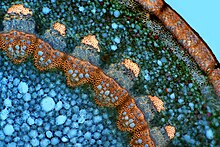en
names in breadcrumbs


Parthenocissus /ˌpɑːrθɪnoʊˈsɪsəs/,[1] is a genus of tendril[2] climbing plants in the grape family, Vitaceae. It contains about 12 species native to the Himalayas, eastern Asia and North America.[3] Several are grown for ornamental use, notably P. henryana, P. quinquefolia and P. tricuspidata.[2]
The name derives from the Greek parthenos, "virgin", and kissos (Latinized as "cissus"), "ivy". The reason is variously given as the ability of these creepers to form seeds without pollination[4] or the English name of P. quinquefolia, Virginia creeper, which has become attached to the whole genus.[5]
Among the middle Miocene Sarmatian palynoflora from the Lavanttal Basin Austrian researchers have recognized Parthenocissus fossil pollen. The sediment containing the Parthenocissus fossil pollen had accumulated in a lowland wetland environment with various vegetation units of mixed evergreen/deciduous broadleaved/conifer forests surrounding the wetland basin. Key relatives of the fossil taxa found with Parthenocissus are presently confined to humid warm temperate environments, suggesting a subtropical climate during the middle Miocene in Austria.[6]
Parthenocissus species are used as food plants by the larvae of some Lepidoptera species including the brown-tail and Gothic.
 Creeper stalk transversal cross section.
Creeper stalk transversal cross section. Parthenocissus /ˌpɑːrθɪnoʊˈsɪsəs/, is a genus of tendril climbing plants in the grape family, Vitaceae. It contains about 12 species native to the Himalayas, eastern Asia and North America. Several are grown for ornamental use, notably P. henryana, P. quinquefolia and P. tricuspidata.